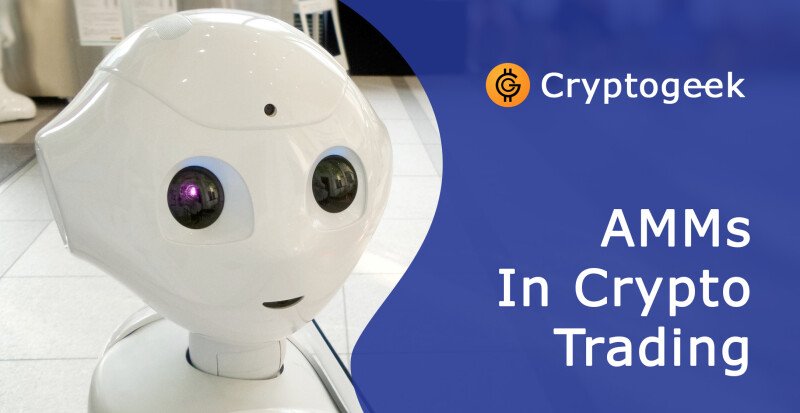Exploring the World of Automated Market Makers (AMMs) in Cryptocurrency Trading


Automated Market Makers (AMMs) represent a revolutionary approach in the realm of cryptocurrency trading, offering a decentralized and user-driven alternative to traditional market-making methods. The inception of AMMs can be traced back to the launch of Uniswap in 2018, marking a pivotal moment in decentralized finance (DeFi). This innovation has since become a cornerstone in the infrastructure of decentralized exchanges (DEXs), facilitating direct cryptocurrency exchanges without intermediaries.
At their core, AMMs function as self-operating trading systems that negate the necessity for centralized exchange platforms and their conventional market-making strategies. This breakthrough allows users to interact in a peer-to-peer trading environment, bolstered by a more transparent and accessible framework. The essence of AMMs lies in incentivizing users to become liquidity providers. In return, these providers receive a portion of transaction fees and complimentary tokens, fostering a participatory and rewarding ecosystem.
This article delves into the intricate workings of AMMs, unraveling how they redefine trading dynamics in the digital currency space. We also explore the broader concept of DeFi and its implications in reshaping financial interactions. By understanding AMMs, one gains insight into a transformative technology that is reconfiguring the landscape of cryptocurrency trading.
Contents
- What is a Market Maker?
- Deciphering the Role of Automated Market Makers in Decentralized Crypto Trading
- Unraveling the Intricacies of Automated Market Makers in the Decentralized Ecosystem
- Unpacking the Integral Contributions of Liquidity Providers in AMM Frameworks
- Enhancing Returns via Yield Farming in AMM Environments
- Decoding Impermanent Loss in the Context of AMM Liquidity Contributions
What is a Market Maker?
Market makers are integral to the functioning of centralized trading platforms, serving as the backbone for liquidity in various trading pairs. These entities, typically comprising institutional traders or large-scale financial organizations, assume a vital role in guaranteeing that there's a consistent flow of buy and sell orders on the platform.
Imagine a scenario where Trader A is keen to purchase Bitcoin at a specific rate. On a centralized exchange, the primary objective is to align Trader A's buying interest with a Trader B who is ready to sell at the agreed rate. Here, the exchange operates as a facilitator, ensuring a smooth matching of these orders. This intermediary role of the exchange is central to maintaining an efficient trading experience, ensuring quick and accurate execution of trades.
At times, the immediate matching of orders isn't feasible, often due to a phenomenon known as low liquidity. Liquidity, in the context of trading, reflects the ease with which an asset can be traded. A market is considered highly liquid if there's a significant presence of traders actively engaging in buying and selling. Conversely, a market is deemed to have low liquidity if there's a scarcity of trading activity, making the process of buying and selling more cumbersome.
In markets with low liquidity, a situation called slippage often occurs. Slippage happens when there's a notable difference in an asset's price from the start of a trade to its conclusion. This is a common occurrence in markets characterized by high volatility, such as the cryptocurrency market. To counter these challenges and ensure timely transaction executions with minimal price variations, exchanges rely heavily on the services of market makers.
Market makers enhance liquidity by placing a multitude of buy and sell orders on the platform. This strategy ensures the constant availability of counterparties for each trade, thus fostering a more stable and efficient market environment. Through their contributions, market makers not only facilitate the smooth functioning of trading on centralized exchanges but also play a pivotal role in sustaining market orderliness, enabling assets to be traded with reduced instances of slippage and delays.
Deciphering the Role of Automated Market Makers in Decentralized Crypto Trading
In the evolving world of cryptocurrency, Decentralized Exchanges (DEXs) have introduced a novel concept known as Automated Market Makers (AMMs), which stands in stark contrast to traditional, centralized exchange mechanisms. DEXs, in their quest to revolutionize crypto trading, dispense with traditional order-matching systems and the need for custodial infrastructure, where exchanges typically control wallet private keys. This shift promotes a higher degree of user autonomy, enabling direct trading from personal wallets where users retain exclusive control over their private keys.
The cornerstone of this decentralized approach is the integration of AMMs. These are not just mere protocols; they are complex smart contracts - autonomous, self-operating computer programs - that are programmed to set the prices of digital assets and ensure the availability of liquidity. In this ecosystem, liquidity is aggregated within the smart contracts, forming what are known as liquidity pools. Thus, in the DEX setting, users are essentially interacting with the liquidity embedded in these smart contracts, rather than trading against specific individuals or entities.
Another significant advancement brought about by AMMs is the democratization of the liquidity provider's role. Traditional exchanges often restrict this role to financially robust individuals or corporate entities. AMMs, on the other hand, have opened the doors to a wider spectrum of participants, allowing anyone who meets the smart contract's predefined conditions to contribute as a liquidity provider. This inclusive approach is a marked departure from the exclusivity of traditional systems.
Platforms like Uniswap, Balancer, and Curve are at the forefront of implementing AMM-based systems. These platforms are not just utilizing AMMs; they are redefining the landscape of digital asset trading, making it more accessible and equitable. Through their innovative use of AMMs, these platforms exemplify how decentralized finance is challenging traditional norms and empowering a broader range of participants in the cryptocurrency marketplace.
Unraveling the Intricacies of Automated Market Makers in the Decentralized Ecosystem
Automated Market Makers (AMMs) operate on two pivotal principles in the decentralized finance (DeFi) sphere:
Transformation of Trading Pairs into Liquidity Pools: In the AMM model, the conventional trading pairs found on centralized exchanges are reenvisioned as distinct liquidity pools. For instance, to trade Ether (ETH) for Tether (USDT), one must engage with a dedicated ETH/USDT liquidity pool in the AMM framework.
Democratization of Liquidity Provision: Contrary to the centralized model where specific entities act as market makers, AMMs open the door for widespread participation in liquidity provision. If one desires to supply liquidity to an ETH/USDT pool, they must contribute both assets in a ratio pre-defined by the AMM system.
The equilibrium of asset ratios in these liquidity pools is governed by mathematical models. A common formula used is x*y=k, where 'x' and 'y' denote the amounts of the two different assets in the pool, and 'k' represents a fixed constant. This formula is instrumental in ensuring the constant value of the product of the two asset quantities, thereby stabilizing the pool’s liquidity dynamics.
To illustrate, let's consider an ETH/USDT liquidity pool scenario. When ETH is bought, traders introduce USDT to the pool while withdrawing ETH. This action decreases the ETH quantity, subsequently raising its price to adhere to the x*y=k formula's balancing principle. Conversely, the influx of USDT lowers its price in the pool. The reverse scenario unfolds when USDT is the asset being purchased.
Significant trade orders in AMMs can lead to notable price discrepancies between the pool and the broader market. For example, a large deposit of ETH in a pool might reduce its pool price to $2,850, while the general market trades it at $3,000. Such disparities create opportunities for arbitrage, where traders can exploit the price difference by purchasing the asset at a lower pool price and selling it at a higher price on external exchanges. This arbitrage mechanism is crucial in nudging the pool price back in line with the prevailing market rate.
It's important to note that the x*y=k equation, a hallmark of platforms like Uniswap, is just one among many algorithms utilized by AMMs. Platforms such as Balancer adopt more complex algorithms, enabling the amalgamation of up to eight digital assets in a single pool. Meanwhile, Curve specializes in an algorithm suited for stablecoin pairings or similarly behaving assets, showcasing the diverse mathematical approaches underpinning the AMM landscape.
Unpacking the Integral Contributions of Liquidity Providers in AMM Frameworks
The role of liquidity providers (LPs) in the domain of Automated Market Makers (AMMs) is indispensable. These participants enrich the AMMs by supplying crucial liquidity, which is fundamental for the efficient operation of these platforms. Encouraging the influx of digital assets into liquidity pools, AMMs depend on these contributions to stave off potential trading issues like slippages, especially in pools lacking adequate funding.
For their valuable input, LPs receive a proportional reward. When they deposit assets into a pool, they are issued LP tokens, akin to a proof of investment and a tokenized share in the pool. This token mirrors the percentage of the total liquidity provided by the depositor. For instance, a 1% contribution to a pool’s total liquidity translates into an LP token that signifies 1% ownership of that pool. These tokens are not just symbolic; they confer rights to a fraction of the transaction fees generated by the pool. Upon deciding to withdraw, LPs can exchange their LP tokens, retrieving their original contribution along with a share of the accrued transaction fees.
Enhancing Returns via Yield Farming in AMM Environments
Beyond the direct rewards of transaction fees, LPs in AMMs can further enhance their financial returns through yield farming. This method begins with the initial deposit of digital assets into a liquidity pool of an AMM, leading to the issuance of LP tokens to the depositor. These tokens, emblematic of the depositor’s stake in the liquidity pool, can be utilized in another DeFi protocol for additional financial benefits. By allocating these LP tokens in such protocols, LPs can earn extra interest, thereby amplifying their financial gains.This approach exemplifies the concept of composability within the DeFi sector, where various platforms interconnect, creating a tapestry of financial opportunities. Through yield farming, LPs exploit the interconnected nature of DeFi platforms, thereby maximizing their revenue potential. It is important to remember, however, that to retrieve the initial investment from the liquidity pool, LPs must redeem their LP tokens. This cycle of investing, staking, and redeeming underscores a dynamic and multifaceted opportunity landscape for LPs in the DeFi ecosystem, enabling them to explore and benefit from various income avenues.
Decoding Impermanent Loss in the Context of AMM Liquidity Contributions
In the landscape of Automated Market Makers (AMMs), a phenomenon known as impermanent loss presents a notable risk for liquidity providers (LPs). This situation arises when the value ratios of assets within a liquidity pool undergo shifts. An LP encounters this type of loss when the price ratio of assets in the pool changes unfavorably from the ratio at the time they initially contributed their funds.The severity of impermanent loss is directly linked to the magnitude of the price variation in the pool's assets. This risk is especially pronounced in pools containing assets with high price volatility, as they are more likely to experience sharp fluctuations in value.The term 'impermanent' underscores the transient nature of this risk. It suggests that the loss may not be enduring, as there's a possibility for the asset prices to realign to their initial ratios, potentially reversing the loss. However, if an LP withdraws their investment before such a realignment, the impermanent loss crystallizes into a permanent one.
While the prospect of impermanent loss is a concern, it's balanced by the potential for compensatory gains. The combination of fees collected from pool transactions and the benefits accrued from staking LP tokens can offer a counterweight to the losses incurred. This interplay of risk and reward is a critical aspect for LPs to consider when participating in the AMM ecosystem, balancing the potential downsides with the opportunities for profit in these decentralized financial platforms.

인기 튜토리얼
-
Что такое хард-форк?Jul 27, 2020
-
Стейкинг на Ethereum 2.0 и его основные особенностиAug 01, 2020
-
Инновации на основе блокчейна в сфере энергетикиAug 03, 2020






contact Maria Renee FX,
via Ema… mariarenee820@gmail.com
Also her WhatsApp contact: +1(732)630-9483, Telegram: @Mariarenee820